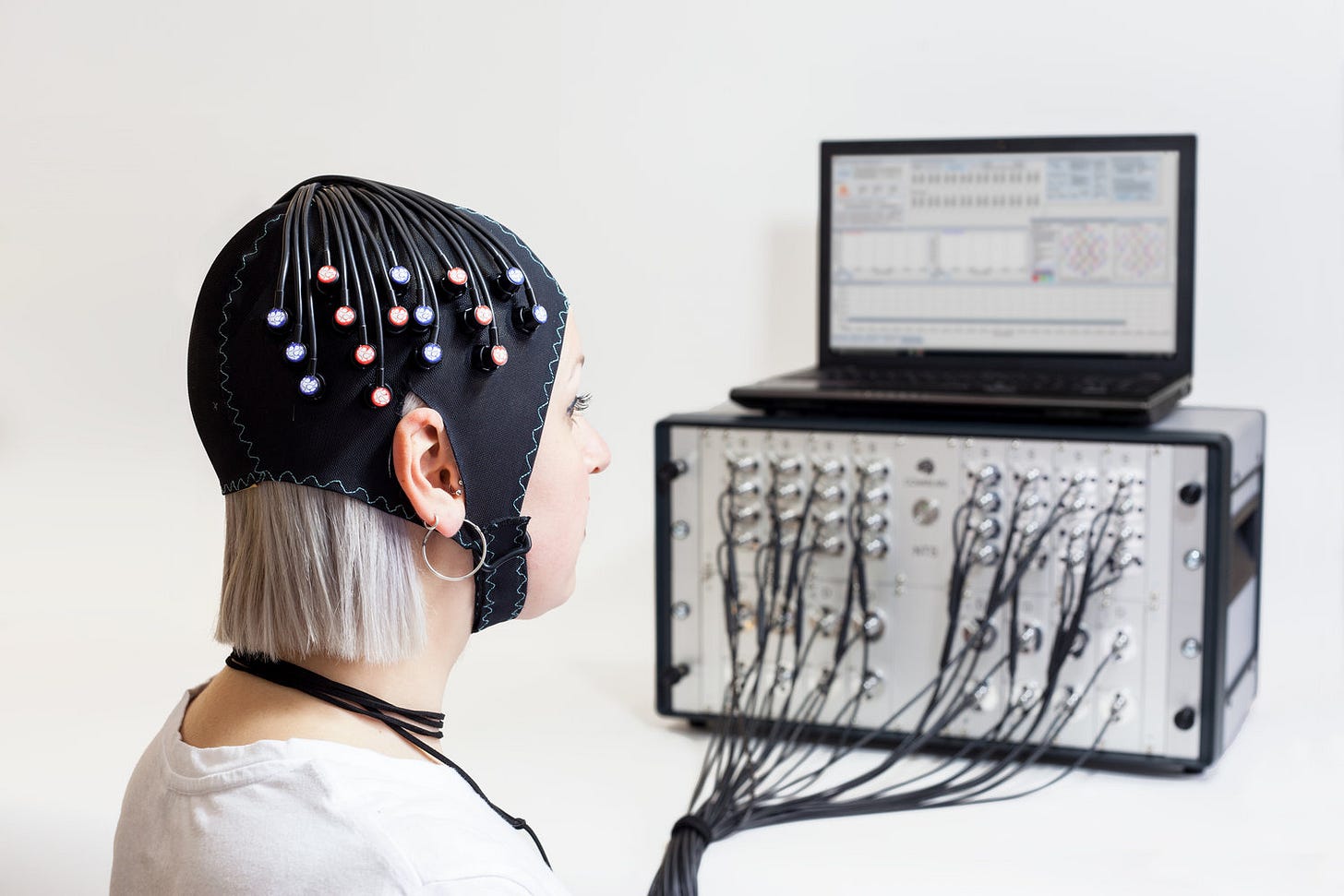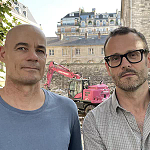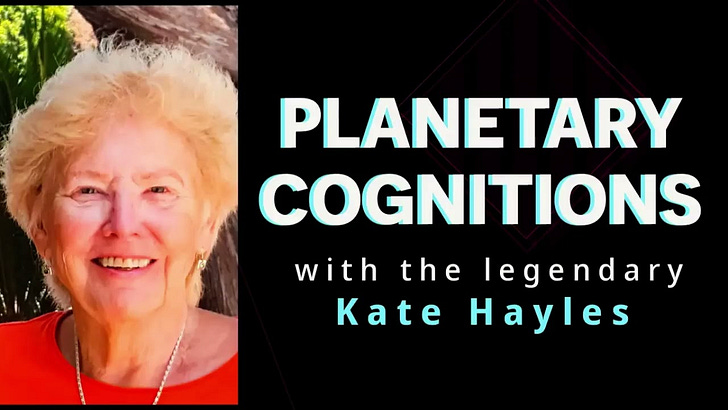Episode #75: A conversation about neural synchrony, how we might model the “third brain” that arises in interaction, and why misalignment matters: with biologist , hosted by philosopher .
We seem to know when we’re in synch, especially when we’re together in person (it’s a little harder via Zoom). Maybe you’re in deep conversation with someone, and you feel the shared flow. You’re finishing each other’s sentences, moving through ideas together like dancers who’ve practiced the same routine. This is that feeling that there is a ‘third entity’ as Beck Todd puts it in another Love & Philosophy conversation (via a term that came from dancer Steve Paxton) where it’s not you and not them but something happening as both.

This might sound magical and it can feel a bit magical, too, which is why we don’t quite know how to talk about it or how to model it in ways that can be rigorous. Other guests on the show have been finding ways through perceptual crossing experiments (for example) or through developing new ways of doing experiments like PRISMA. This week’s guest, Nicolas Hinrichs, is trying to develop mathematical and experimental models that might be able to help us better express and visualize what is happening via the data we record in neural activity.
But even without all those EEGs, fMRIs, and fNIRS, as a living experiment, it’s pretty natural and easy to observe this in yourself, if you take seriously that we are co-creating reality together as we communicate. In everyday moments, we can notice how a conversation or interaction with someone (even through a book or television show or podcast) can create a different sort of thought cloud around us for a time, and how this shapes our ways of thinking through the day. This is powerful stuff, the ways we shift one another potentials.
All that seems to imply being in synch. But what if the most interesting (and perhaps most important) moments in human connection aren’t only about being perfectly in sync? What if all that wonder and magic is also about the places we ‘misalign’ so that it’s about the dance and the ways we react to those misalignments together that creates the wider dynamic?
That’s one of the provocative ideas of this week’s Love & Philosophy conversation with the Chilean-German neuroscientist and biologist Nicholas Hinrichs.
Nico specializes in something called hyperscanning, which is a technique that might sound like science fiction but is increasingly revealing profound truths about how we connect. The basic idea is that instead of studying one brain at a time (the traditional approach), researchers record the brain activity of two people simultaneously while they interact.
Imagine two people wearing electrode caps (like shower caps covered in sensors) or lying in adjacent brain scanners while, talking, playing games, or working together. Scientists can then watch in real-time as patterns of brain activity ripple through both brains (or the parts of the brain they are watching), sometimes aligning, sometimes diverging, always in motion.
By doing this, they are finding that during social interactions, certain brain regions synchronize between people. Our nervous systems (Andrea and past guests would say ‘our entire bodies’) really coordinate together. We change each other’s movement, pace, and patterns by being in conversation, and that doesn’t only mean being in conversation with words.
Still, most study and model synchronization, looking for and finding these moments of synchrony and treating them as a standard of good communication.
Hinrichs thinks this is too simple, and that we need other ways to visualize the dance that is happening between bodies and their brains. As he puts it:
“If you think of interaction, it’s not just that you move in the same beat and then that constitutes your relevant marker... I think of it more as a choreography. And so there you also have other layers on top of the beat... and maybe sometimes that loosens or tightens and definitely shifts.”
In other words, real human interaction isn’t like two metronomes clicking in perfect unison. It’s more like a dance and in any dance, there are moments of coming together and pulling apart, of leading and following.
Under the traditional view, when two people’s brains fall out of sync during conversation, that’s called ‘noise’ which is something to be filtered out of the data, a sign that communication has broken down. Scientists usually do not put this into the final results and it can be overwhelming to the experiment to have too much of it. But how might we create tools that use the noise?
Hinrichs argues that misunderstandings, tensions, and ruptures aren’t noise at all. They’re ‘signals’ too, to put it in experimental terms; they’re meaningful.
Some of the most transformative moments in relationships happen precisely when we’re not aligned. When you realize your friend has been processing your conversation completely differently than you have, that opens a portal for a new understanding between you.
These moments of misalignment, what Nico mentions in the conversation as “phase transitions”, might actually be where the deepest understanding happens. They’re not failures of connection; they’re part of the process of connecting. This is hard to hold, but also where the potential is.
One of the most beautiful ideas in the conversation is what Heinrichs calls “the third brain”, an idea which threads with previous L&P conversations to express this emergent process that exists between two or more people in interaction (or maybe even between you and yourself at times).
Hinrichs is developing what he calls “geometric hyperscanning” to try to capture and visualize this third entity. Instead of just taking snapshots that show “aligned” or “not aligned,” he’s looking for ways to map the actual choreography, the dynamic, shifting patterns of how two or more brains move through interaction together. He and Andrea discuss ways of modelling this as “constellatory cognition” (or what Andrea discusses as kaleidoscopic), suggesting that maybe we can think less about linear alignment and more about multiple dimensions of connection happening simultaneously.
You might be synchronized with someone in one way while completely out of sync in another. You might be talking about the future while they’re thinking about the past. You might be sharing the same space while experiencing it entirely differently.
And all of that is okay. In fact, it might be essential. Which brings us to one of the central themes of the podcast: holding paradox. This does not mean solving one side into the other side but exploring the spaces holding them.
As Andrea puts it in her introduction, this is about “trying to hold what feels irreconcilable”, refusing to collapse complex realities into simple either/or categories. Connection isn’t either synchrony or misalignment. It’s both, all at once, in constantly shifting configurations. The dimensions of this are still beyond what we have been able to visualize, which is why conversations and attempts like this are so important.
Hinrichs sees this as more than just a philosophical stance. For him, it’s “a kind of care”, a way of attending to the full complexity of human experience without trying to reduce it to something simpler and more manageable. As he explains:
“If we do not steer ourselves in holding that paradox meaningfully, then we will tend to gravitate towards what I call unnamed centers of attraction... that can fill your own discourse of considerations, you know, or the considerations of your own praxis if you leave that unchecked.”
In other words, if we don’t actively work to hold complexity, we’ll unconsciously drift toward oversimplified explanations that might serve other agendas that we do not even know we are serving, be those personal, commercial, political, or communal.
Care is what really matters at the end of the day. Specifically, Hinrichs wants to understand human connection better so we can help people who are struggling with mental health, with relationships, with feeling isolated or misunderstood.
That’s why he and another guest from a previous show Mark James are working on something called “neuroprotective rituals”, which are ways of using interpersonal synchrony to help people cope with stress, chronic inflammation, and the neurobiological effects of things like social inequality. The idea is that if we understand how our nervous systems coordinate and regulate each other during interaction, we might be able to design practices that actively support mental health.
And it’s why the complexity matters. As Hinrichs notes, current mental health intervention often relies on what’s called “clinician’s intuition”, which is valuable but also, he argues, “not enough.” We need to understand what’s actually happening at multiple levels when two people interact, especially in therapeutic contexts, and how it is unique for everyone. Not easy, but worthy of trying to find new ways to create experiments and model data that consider this.
One thing that is striking in this conversation is how Hinrichs’s approach to science mirrors the quality of human connection he’s studying.
He grew up with a cellist mother and a theoretical physicist father, so art and hard science, discipline and expansion, were held together. He also grew up with multiple cultures and languages and learned early that both/and perspectives matter, that you need to “juggle.” His work now sits at the intersection of biology, phenomenology, philosophy, and mathematics, holding the space of many a lens.
When asked how hyperscanning might help us care for each other better, his answer was beautiful and concise:
“I think what geometric hyperscanning can offer us is to name the moments that matter in human connection, and by doing so, we can make them tractable for care.”
To name the moments that matter. Not to control them, not to perfect them, but to see them clearly enough that we can tend to them. Maybe true connection isn’t only about synchrony. Maybe it’s about something more complex, more dynamic, more human— the ability to move through alignment and misalignment together, to hold the paradox, to stay in the dance even when (or especially when) we’re out of step. Noticing this and working together on the dance might open new sensual potentials, including of the cognitive sort.
Check out the full podcast episode on Love and Philosophy, and watch for Nicholas Hinrichs’s presentation at the upcoming Active Inference Symposium. The preprint of his geometric hyper scanning paper is also available for those interested in the technical details.
Invitation to share: What moments of misalignment have taught you something important about connection?
Papers and references:
Active Inference Institute and Symposium
Geometric Hyperscanning of Affect under Active Inference
On a Geometry of Interbrain Networks
Both Hinrichs and Hiott will be giving papers at this year’s Active Inference Institute Symposium.
Another episode mentioned in this podcast is A Map is its Own Territory:
Sometimes A Map is Its Own Territory with Mahault Albarracin
Join us as we try and discuss what cannot be discussed.
For those more interested in the machine learning and maths side of this, we recommend listening to Hinrich’s on Rahul Sam’s podcast or check him out on Substack here.

Also see this conversation: Complexity Fatigue & The Third Entity with Rebecca Todd, Shay Welch and Penijean Gracefire



















